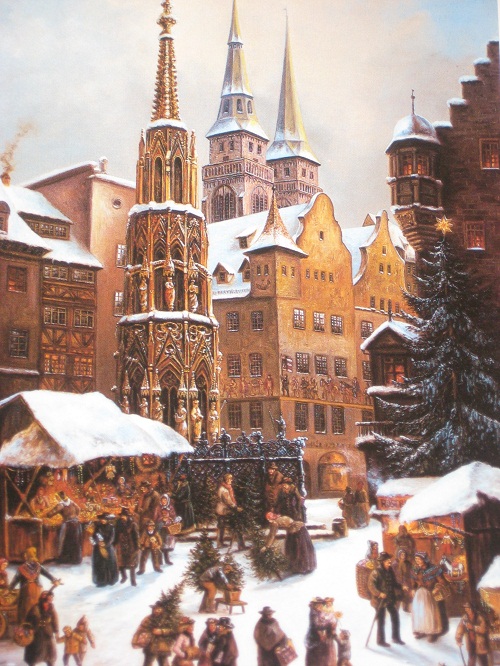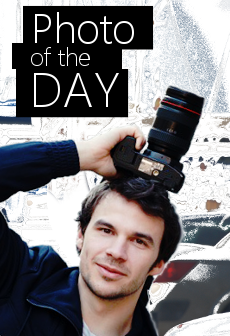Klara Barcic
Memories are timeless. And precious. They are locked in our hearts for ever and we can think and talk about them at any time. And what is even more important, no one can take them away from us. They are part of our being, and as memories are like that, it is good to remember in this festive period the Christmas market (Christkindlesmarkt) we visited in Nuremberg last year.

Photo: Nuremberg: At the Beautiful Fountain, after a painting by Werner Zapf; by Klara
I still remember that long journey by bus. Austria and the part of Germany we went through were immersed in a white blanket of snow. When we arrived in Nuremberg the river Pegnitz had already disappeared into the dark clouds of the night. And all was quiet. Our frozen cheeks and warm coats were caressed by snowflakes incessantly and lovingly. Besides the cheerful voices of many visitors, we could hear freezing snow under our feet. A short evening walk wouldn’t be enough to get acquainted with the city, but it was enough to realize that Nuremberg is a great place, reserving many surprises at every corner. But, no worries, Saturday was there at our disposal to penetrate its secrets.
The heart of the Old city, the Main Square (Hauptmarkt) which hosts the Christmas Market, is swarming with people from all over the world. The magnificent wooden stalls abound in all sorts of goods: handicrafts, food, Nuremberg Lebkuchen, spicy gingerbread, fruit loaves, Christmas tree ornaments and candles. It is getting chilly so it’s time to have a mug of mulled wine (fabulous!) and a roll with Nuremberg roast sausages. “Nuremberg Plum People”, little figures made from prunes, look at us in a friendly way.
At noon sharp all the visitors raise their eyes to heaven: the “Männleinlaufen”, a mechanical clock installed on the west facade of the Frauenkirche (the Church of Our Lady) starts to chime. What makes it particular is the presentation of the seated Holy Roman Emperor surrounded by seven prince-electors dressed in red. The scene commemorates the Golden Bull of 1356.
Enchanted by the performance of the “Männleinlaufen” we enter the church, a masterpiece of brick Gothic architecture. A lady illustrates a short history of the church. After that we are blessed with the magic sounds of the organ. While listening to the music of Bach and Mendelssohn we dream about our secret wishes and the necessity of turning the Ring of wishes (“Wunschring”) on the Beautiful Fountain (Schöner Brunnen) built in the 14th century.
According to legend the ring of golden colour was inserted in the protective railing by a locksmith apprentice without the knowledge of his master. Richly inspired by what we’ve seen and heard in the church we cross the market square and we see the imposing Beautiful Fountain in front of us with its forty stone figures arranged in three rows.
And, of course, we turn the ring of wishes with the firm hope that our wishes will be fulfilled someday. But we won’t tell anybody whether this happened or not; after all this is our secret, as secret are our wishes.
Pushed by an immense crowd we follow the path toward the Imperial Castle. It is slippery, but we do not want to give up. Astonished at the amazing building we decide to take a guided tour. Rooms follow each other, like beads on a string: The Knights’ Hall, the Emperor’s Hall, the Double Chapel, the suggestive Inner Castle Courtyard, the Deep Well and the Sinwell Tower.
At the end of the tour we cannot resist the temptation to climb up the Sinwell Tower. Our efforts are richly rewarded: from the top of the Tower a breathtaking view over the city fills our hearts with immense joy and tender poetry.
Photo: The Imperial Castle; by Klara
Photo: The Imperial Castle; by Klara
Step by step twilight sneaked into the town. The lights of the Albrecht Dürer’s House are still on. We enter and try to imagine the way of life the great Renaissance painter lived in the house from 1509 to his death in 1528. A tour takes us through all four floors containing exhibits devoted to Dürer’s life and works. None of the artist’s original paintings are on display, only the copies. But the etchings and woodcuts are original. Both, copies and original works, witness the great influence the painter had on other artists.
Leaving the Dürer’s House behind us we get involved with the free and easy atmosphere of the Christmas market. The smell of mulled wine is getting more intense and the crowd almost unbearable.
Before we leave the crowd we pop in St. Sebaldus’ church, Nuremberg’s oldest parish church. St. Sebaldus, a hermit and missionary, who presumably lived in the 11th century, is venerated as the patron saint of Nuremberg. The legend says his corpse was put on an oxcart and was buried in the place where oxen refused to go further. The church was built in his memory on that exact site.
Photo: St. Sebaldus’ church; by Klara
Photo: St. Sebaldus’ church; by Klara
There are numerous great buildings, like for example the Town Hall built between 1616 and 1622; it was never completed the way it was originally planned, but it is still very impressive. There are many other monuments and sites, witnessing Nuremberg’s rich history, which generous artistically talented people created and built over the centuries, but unfortunately we didn’t manage to see all of them even though we did a lot of walking. But a lot is never enough. What is important when leaving a place one likes is the hope that this place will be the destination of one’s future travels again. This hope makes farewells easier.
Photo: The Sinwell Tower; by Klara
The Pegnitz is about to wake up from its night-long dream. It seems to be somewhat lazy. The bus is waiting for us and alas we have to leave. Though it is hard to say good bye, I am happy because the heart of Nuremberg turned a day of my life into a precious diamond.
While I am sinking into the warm bus seat, I dream away of kings, emperors, musicians, painters, philosophers, poets and all those who with their culture and knowledge enriched Nuremberg’s past. I turn around and I see the Sinwell Tower dominating the city and its amazingly clean roofs. In a snow-white picture frame the lights of the Christmas Market shine upon our path and memories.
Photo: Nuremberg’s roofs; by Klara











1 comment so far ↓
Nobody has commented yet. Be the first!
Comment